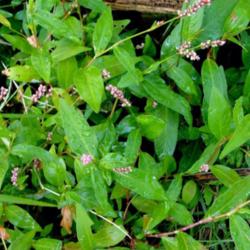
Smartweed (Polygonum pensylvanicum) and closely related lady's thumb (P. persicaria) are a shade gardener's worst nightmare, because they grow best in moist partial shade. Found throughout North America, these native annuals produce thousands of hard-coated seeds. Plants occasionally grow to 4 feet tall, but even when mowed repeatedly smartweed often manages to produce flowers. Very young plants can be killed with an organic herbicide containing clove oil. After they have several leaves, pull them instead. Reduce reseeding by cutting back any plants that manage to produce pink flowers. Flamers are sometimes used in seriously infested fields.
Weed Control TechniquesOrganic herbicides. There are several herbicides made from natural ingredients. Those that contain clove oil (eugenol) give the best control of young broadleaf weeds. Products containing acetic acid, often in combination with citric acid, do a good job on young grasses. Some products contain both clove oil and acetic acid, so they are useful for a broad variety of weeds. Soap-based herbicides dehydrate leaves by cutting through their protective layer of cutin. All of these types of organic herbicides work best on young weeds and pose only a temporary setback to well-rooted perennial weeds. To minimize damage to neighboring plants, spray only in dry, still weather. To maximize effectiveness, spray young weeds when temperatures are above 70 degrees F and the sun is shining brightly. Be aware that repeated applications of a product containing acetic acid (which is very strong vinegar) can lower the soil's pH, making it more acidic.
Pulling. Most young weeds can be pulled from the soil. They will slide out most easily if you pull them when the soil is wet. Getting the root up is crucial, so think of the main stem as the root's handle, and grasp it as close to the soil line as you can. If you find that the weeds are breaking off at the crown as you pull, slip a kitchen fork, dandelion weeder, or similar tool under the weed, and pry and twist as you pull it up. Weeds that have taproots, such as dandelion and plantain, usually must be pried out. A flexible pair of waterproof gloves will keep your hands comfortable as you weed, and it's good to have a nice sitting pad, too. Let pulled weeds bake in the sun for a day or so before composting them. If pulled weeds are holding mature seeds, compost them separately in a hot, moist pile before using this compost in the garden.
Reducing reseeding. Most weeds reproduce primarily from seeds, and the seeds of some weeds can remain viable when buried in the soil for decades. So it's essential to keep weeds from shedding seeds in the garden. Garden weeds that are neglected until they reach seed-bearing age can be lopped off near the soil line with pruning shears, a stout knife, or a string trimmer with a blade attachment. Cutting back perennial weeds again and again not only reduces reseeding, it also forces the plants to use up food reserves stored in their roots. In a garden that has gone hopelessly weedy, mowing it down promptly, raking out the seed-bearing debris, and starting over next year is a big step in the right direction. Mowing regularly helps keep weeds under control in lawns. When mowing lawns where seed-bearing weeds are present, collect the clippings in a bagger and dispose of them in a shady place.
Flaming. Flamers are portable gas torches that produce heat intense enough to boil the water in plant cells. Killing a weed requires heat for only 1/10 of a second. Flamers are usually used to kill young weeds in prepared rows, just before seeds or seedlings are planted, as an alternative to pre-emergent herbicides. Flamers become trickier to use later, when the plants are actively growing, and they cannot be used where mulches are present. Flamers also are quite costly compared to a hoe, but may be a worthwhile investment if you have a number of straight rows to weed. They also are useful for killing weeds in between walkway pavers. The smallest models consist of a backpack that holds propane fuel, a hose, and a hooded nozzle at the end of a handle that resembles a carpet sweeper.
Image courtesy of Randall G. Prostak, University of Massachusetts